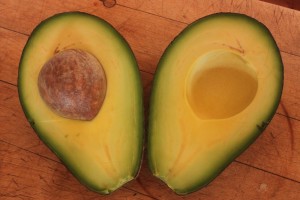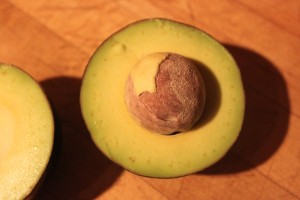September 2, 2020
Updated January 3, 2024
“What avocados would do well in my Bay Area backyard?”
It’s the most oft repeated question we field here at avocado central. The answer really depends on where you’re planting your trees. If you’re in the fat of the avocado growing region, with good winter sun and infrequent frosts, you can find success with a huge list of great avocado varieties. If you are in a less than ideal situation, your choices narrow and quality can suffer. One thing is certain, you cannot just head down to the garden store and pick-up whatever they have in stock. You could easily end up with a Fuerte, a Little Cado, a Stewart, a Holiday, or a Sir Prize, which can be counted on to underperform in our area.
You also cannot just take one of each of the varieties that we propagate. Some of our types are rare and excellent avocados that just don’t work well here: Edranol, Nabal, and Nimlioh are great avocados that need much warmer nights during bloom-time to be dependably productive. We grow them to sell to collectors or people in LA and San Diego…
To answer the question of which avocados to grow, you have to be talking about one particular place, as the answer is different for each location.
We live in Watsonville CA, on the coastal terrace, ¾ mile from the beach, 175’ in elevation, at the foot of a rise that drops cold air our way in winter. We had frost for 25-30 days last year (2019/20), but no temps below 29 degrees. A cold winter will see 25 degrees or lower, occasionally down to 20 degrees.
So our location is a little on the cold side of typical for Santa Cruz County, and can be used as an index for the greater bay area. If your location is more favorable, all the better. If you are situated in a cold pocket, or live farther north, I’ll touch on that as well.
For our location, four avos stand out: Carmen Hass/Phoenix, Reed, Palo de Oro, and Lamb Hass.
The Phoenix is singular in that it can be counted on to produce two distinct crops per year. It blooms in the spring like most avocados, and generally sets a good crop. Unlike any other avocado, it produces a full bloom again in September-October. The fall bloom actually staggers on through the winter months, much like Pinkerton, Hass, and other avo varieties, popping out a few clusters as the temperatures permit. If there is a warm spell lasting more than a couple weeks, fruit could be set, but our temperatures tend to be too low to produce a meaningful winter crop. In March and April, this tree will ramp up and pump out a full bloom.
The nice thing about a fall flowering, is that the honey bees are rather desperate this time of the year, as very few other plants are blooming. Despite their indifference to avocado nectar and pollen, they are forced to choose between avocado and nothing. Since pollination is one of the weak links in avocado productivity, the bees’ desperation works in our favor. As long as the weather cooperates (moderating between 50 and 90F), the fall fruit-set tends to be heavy. This crop will ripen 14-16 months later, half a year behind the regular spring crop.
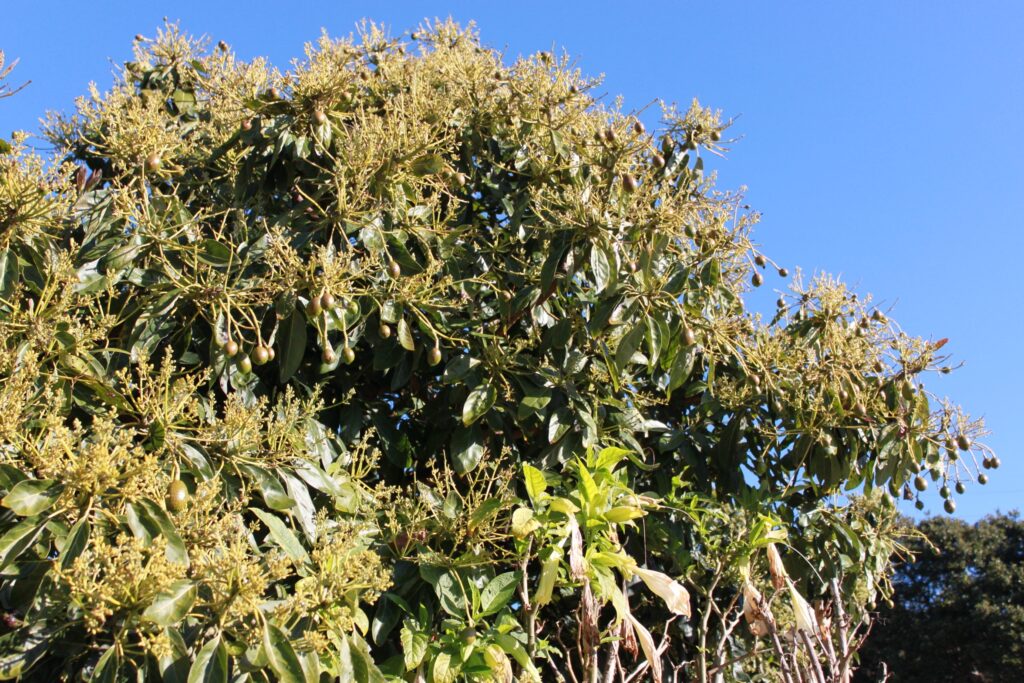
Since the Carmen is essentially a very slightly mutated Hass, they share the ability to hold ripe fruit on the tree for six months or more. In a good year, the last of the spring crop can still be hanging-on while the first of the fall crop is coming in (you can tell the difference between the two crops by outward color, and the fall-set fruit tend to be rounder than the spring set). This one variety can be a quick ticket to year-round avocados. The flavor it should be noted, is excellent: Rich, dense and fatty. It is an unbelievable treat to cut into one of these in March, when only watery types would otherwise be available. We’re so enamoured, we planted three. When one takes the usual year (or half year) off after a bumper crop, we could, theoretically anyway, have a back-up ready to step in. Phoenix, Carmen Hass and Mendez#1 are different names for the same variety.
Reed Is another excellent avocado for us. It has everything. It’s a narrow tree that can be kept to a tidy size and fits well in small spaces. In vivid contrast to some of the other compact varieties, like Littlecado and Holiday, this one puts out fruit like no other. Very precocious, Reed often has fruit on it from the nursery, but can be counted on to set a crop after the first year of substantial growth. If you feel like you might die pretty soon, plant this one, because it wastes no time.
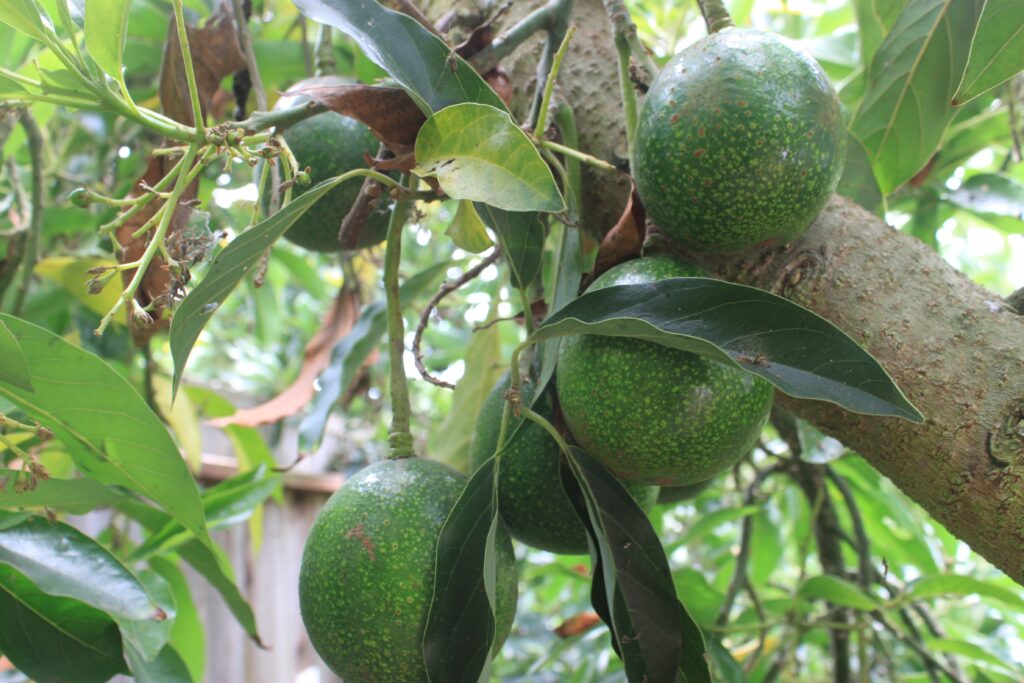
This is a smart tree that would be used in official/commercial breeding programs, except for the fact that it’s fruit is round and very big, and looks nothing like Hass, three traits which disqualify it for the mass market immediately. The smart thing about this tree is that it blooms last every year, often into June, when some avocados are done by late April. Later blooming means flowering into warmer weather, which is what the avocado requires to produce. Give an avocado warmer night-time temperatures at bloom, it will give you a bigger crop.
Hefty harvests normally won’t happen two years in a row. Avocados are notoriously biennial bearers. Following a pattern of boom and bust, weak crops follow strong ones as the tree recharges from the exhaustion of bearing hundreds of nutrient dense fruits. Reed is one of the very few avocados to buck this trend. Our tree set fruit the second year in the ground, and has held heavy loads nearly every year for the last dozen. Only thing to dissuade it seems to be extreme cold, extreme heat, and abject neglect. Maybe the dark green, densely leafy habit of this tree betrays the possession of some enhanced ability to convert sunlight to carbohydrates that could partially explain its prodigious productivity, but I have yet to see a study confirming this.
Did I mention that this avocado is big and delicious and nutty and creamy? It also ripens late in the season, from November thru March around here, when there are not so many fruits of any kind around, filling the harvest gap immediately preceding Zutano, so a valuable type in the pursuit of year-round avocados.
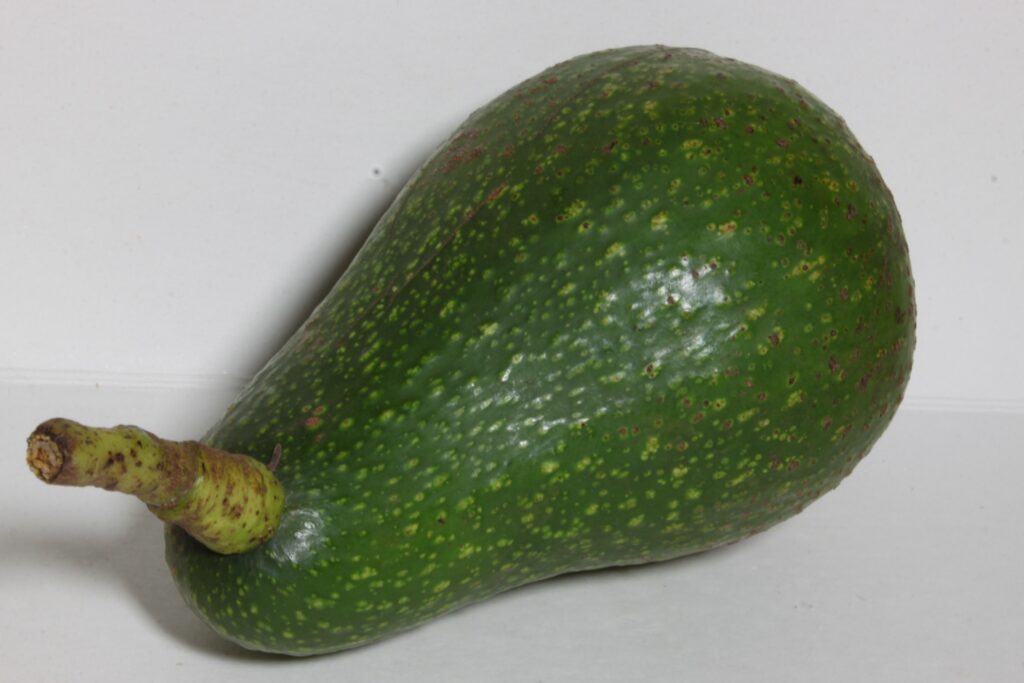
The next fruit in our elite line-up is an avocado that is solidifying its reputation as an outstanding specimen, the Palo d’Oro. Originating in the 90’s in the Palo Colorado canyon area of Big Sur, this Pinkerton seedling has very good flavor and the necky shape of its parent, but is bigger and seemingly even more precocious and productive. It also seems to have lost the uneven-ripening that Pinkerton can suffer from. We have been fruiting and selling it for over 5 years now, and have seen that it belongs among the group of must-plant avocados.
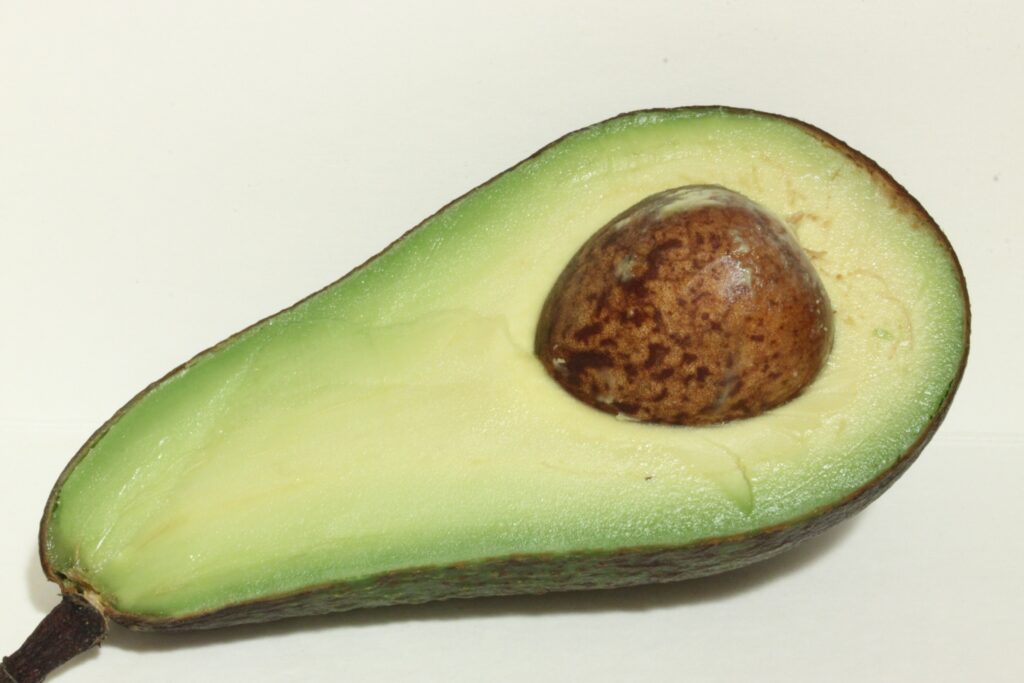
With a rare combination of vigor and hard-to-match precocity, Palo can produce a strong tree ready to set fruit after the first year in the ground. In addition to precocity, it has proven to be a very consistent producer along with strong growth, and minimal biennial bearing tendencies. Consistent bearing indicates a resilient tree that is able to recover and reprovision from the strain of fruit production.
The cold spring of 2022 showed us there is another aspect to Palo de Oro’s productivity: Inhospitable bloom conditions prevented almost all of our other avocados from setting decent crops. Not so the Palo de Oro. It started setting early in March, and continued to set through April and May, resulting in a tree loaded with fruit once again, and demonstrating it’s toughness of flower and adaptation to cool spring conditions that would foil other varieties (except perhaps Reed). On the other end of the continuum, it’s pleasantly surprising to hear our friends from the Central Valley exclaim over Palo de Oro’s willingness to thrive and produce delicious fruit with 100 degree-heat over much of the summer.
The Lamb Hass is great because it is precocious, productive, and delicious. The fruit looks like a broad-shouldered Hass, though not closely related, and shares the name for marketing purposes only. It’s bigger, with a smaller seed, peels easier, and tastes as good or better. The tree is vigorous and fast growing, will begin bearing several years earlier, and out-produce Hass more than 2–1 over its lifetime. It should be mentioned that we have noticed some cold sensitivity in this variety. When the weather during bloom is cold, it is shy to produce. Reed and Carmen escape this problem by respectively blooming really late, and trying again in the fall. Palo de Oro is tough enough to withstand a little cold, but the Lamb seems to suffer.
Lamb’s ripening season in our yard is very roughly Sept.-February, but that date, like any avocado ripening date, can vary widely from place to place, year to year, depending mostly on temperature. If it’s warm in the winter, the trees bloom early. If the trees bloom early, the crop ripens early. (We were picking Lambs in June this year, which is weird.) Whenever you read about avocado ripening times (even mine), assume they are wrong. They are usually based on Southern California (or just different) conditions, which are far warmer, and therefore earlier, than our actual ripening times.
(So as for avocado ripening times, here is a link to the ripening windows for the varieties we grow, as observed at our place, which is as I said earlier, is a little on the cool side for the Monterey bay area. Use this chart as a reference, not a bible. Perhaps your spot will be a little earlier or later, and things will certainly vary from year to year, but it’s a starting point for us up here in Northern California.)
There are other great avocados, which I will go on to discuss, but for a major proportion of the sites in our area, the above four form a solid backbone of excellent quality, big-producing trees that would keep any household well provisioned.
Once this baseline is met, it can be rewarding to explore other possibilities. The Hass avocado, for example, is excellent, can be highly productive, but has a well-earned reputation of being slow to come into bearing. Ours was in the ground 14 years before it became dependably prolific.
The Santa Clara Gold is a new avocado for us, and we have not actually fruited it yet in our yard. We have a tree grafted summer-before-last that is overhead and starting to form flower buds. The mother tree over in Santa Clara, CA has ripened heavy crops of richly-flavored, one-pound fruits the January after bloom in each of the last three years we have observed it. The owner of the tree says it hasn’t missed a beat in the decade he’s owned the house. We need to see how this tree preforms in different situations before we over-promise too much, but we are convinced: This is an avocado to watch.
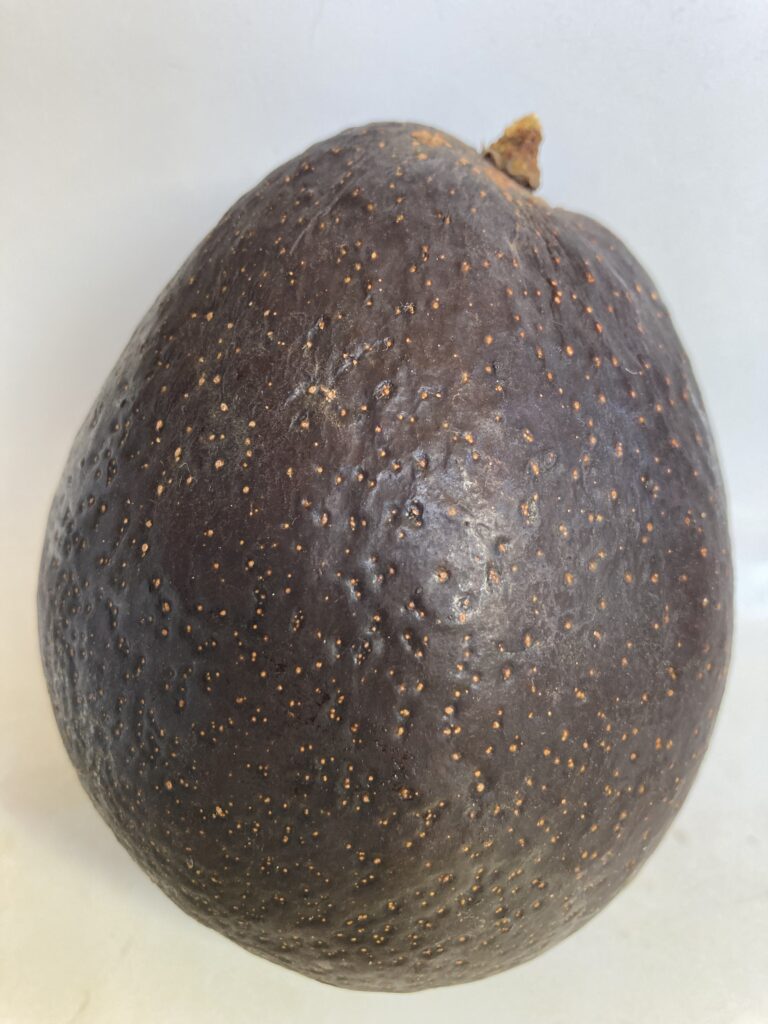
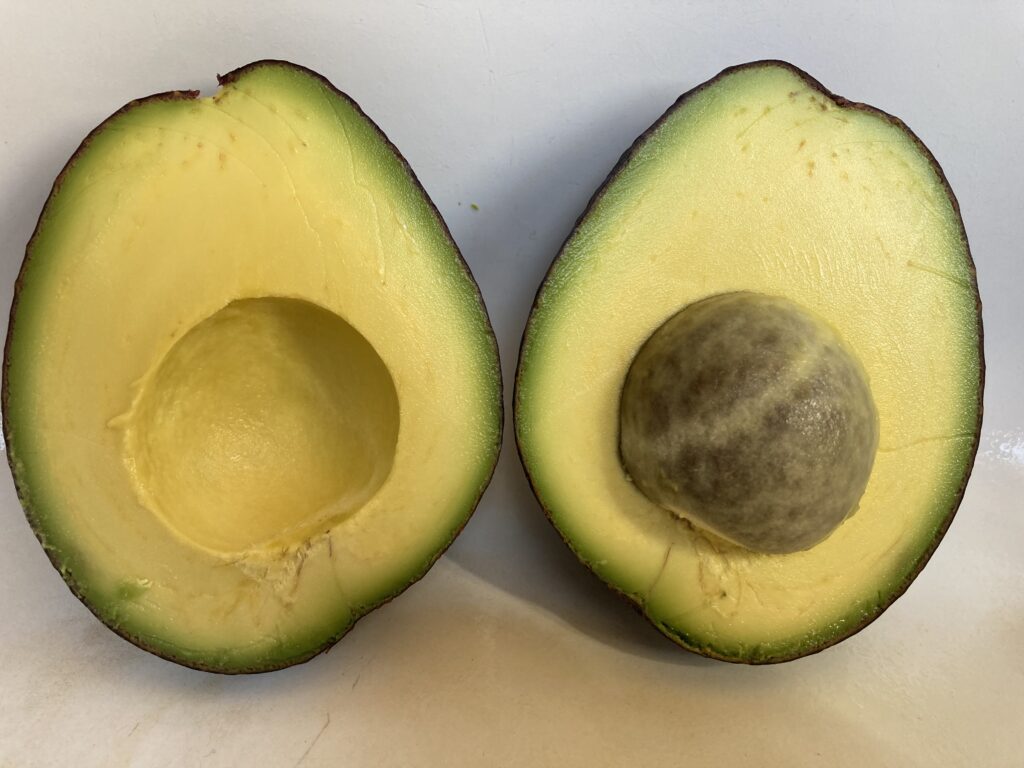
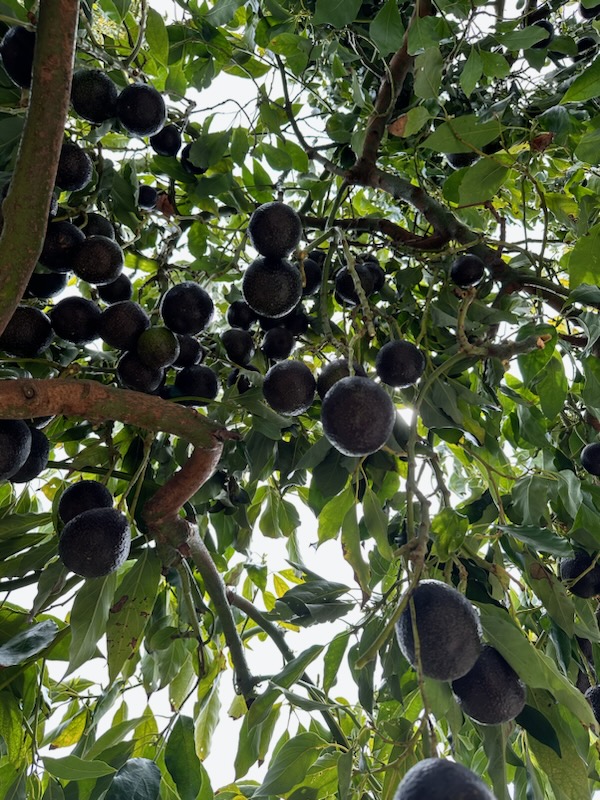
Gwen is a green-fruited avocado that looks otherwise much like a Hass. A dwarf tree, this one stays small because it fruits so abundantly. Being a weak grower, it needs a good site and careful attention. The effort is absolutely worth it, as the abundant fruit is easy-peeling, oily and rich and exceptionally good. This one is suspected of being pollen picky, fruiting best if planted among unrelated avocados (any variety other than Lamb, GEM, or SirPrize). Most avocados don’t need a pollinator in our climate.
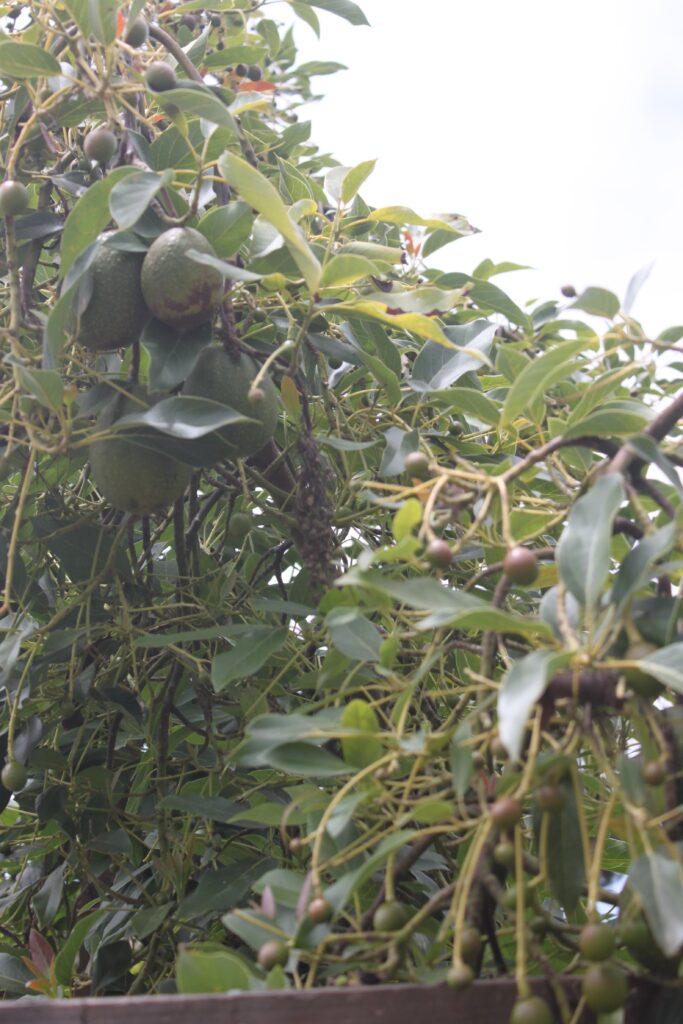
Bird Avenue has shown itself to not only be a good grower and a good producer, but an outstanding eater as well. This is a big tree that needs its space, but we don’t begrudge ours intruding upon its neighbors. The distinguishing thing about this nondescript avocado that looks just like a market variety Hass, is that it has a much higher fat content. We consider it to be in a class with Greengold and Malama, except the Bird Avenue tree actually grows and produces fruit for us. The only thing keeping this avocado out of our “must-plant” roster is that it take up a lot of space, and that we haven’t grown it for very long, and so can’t say how it performs year after year.
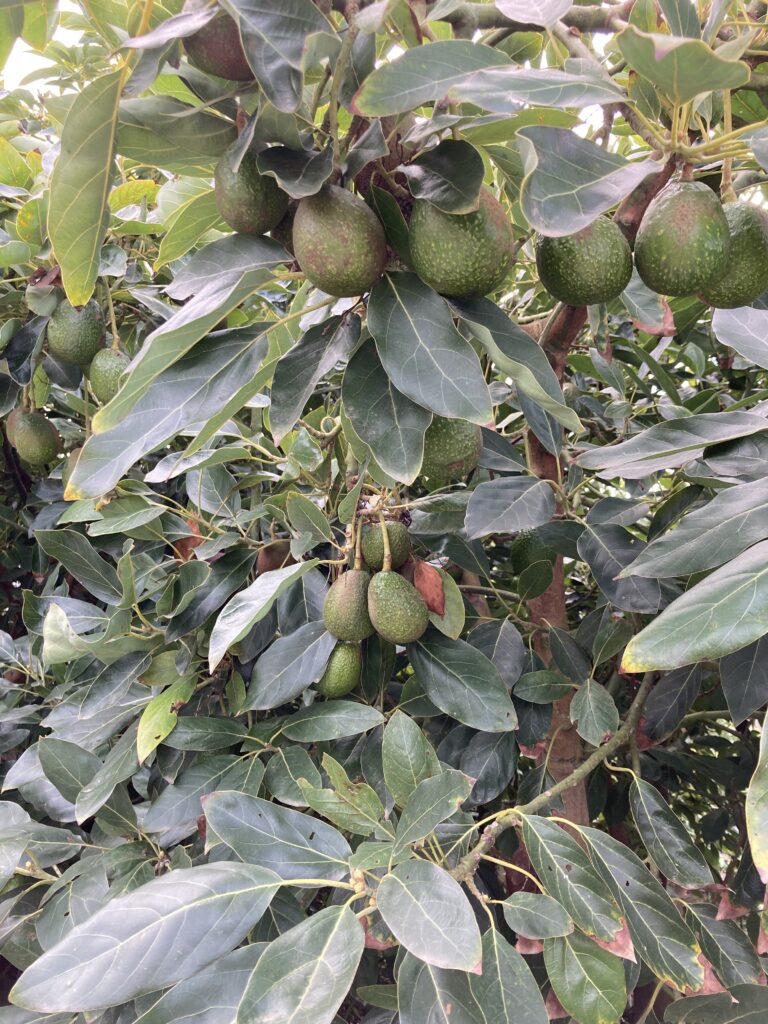
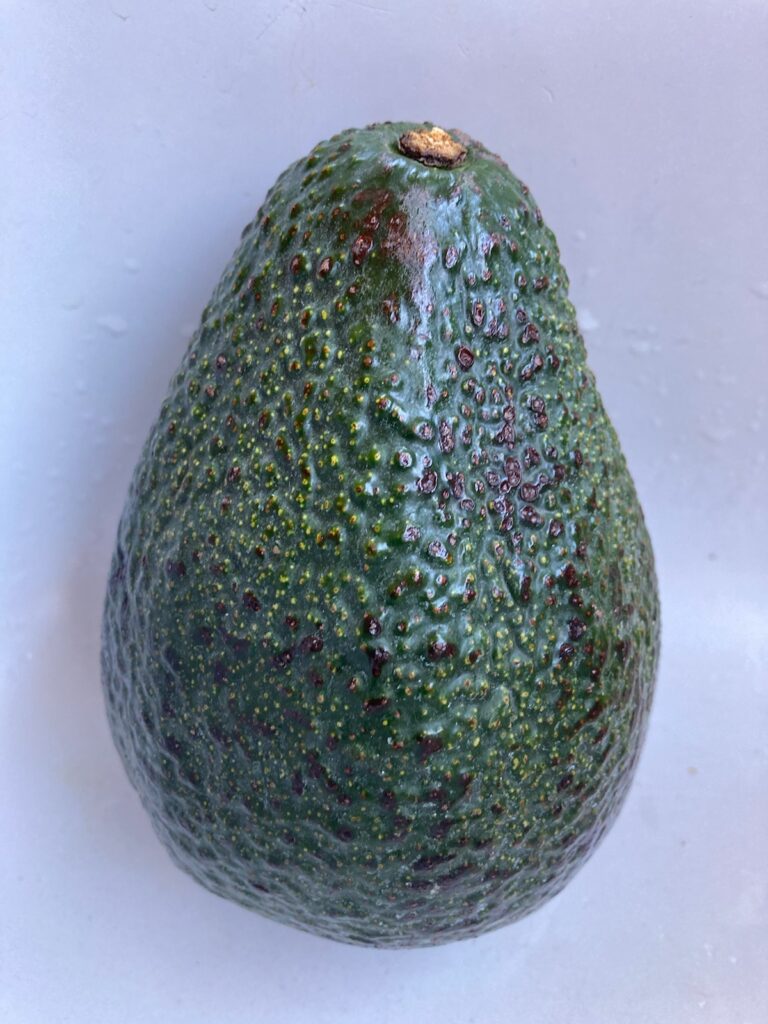
Pinkerton is a wonderful fruit that can ripen from spring into fall, has the virtues of consistent production, small seed size, and great flavor, but in the more coastal, cooler parts of our county, it can ripen irregularly. It has an unusual shape, featuring a long thin neck. Our local squirrels appreciate this trait, using the narrow end as a handle by which to carry off our crop.
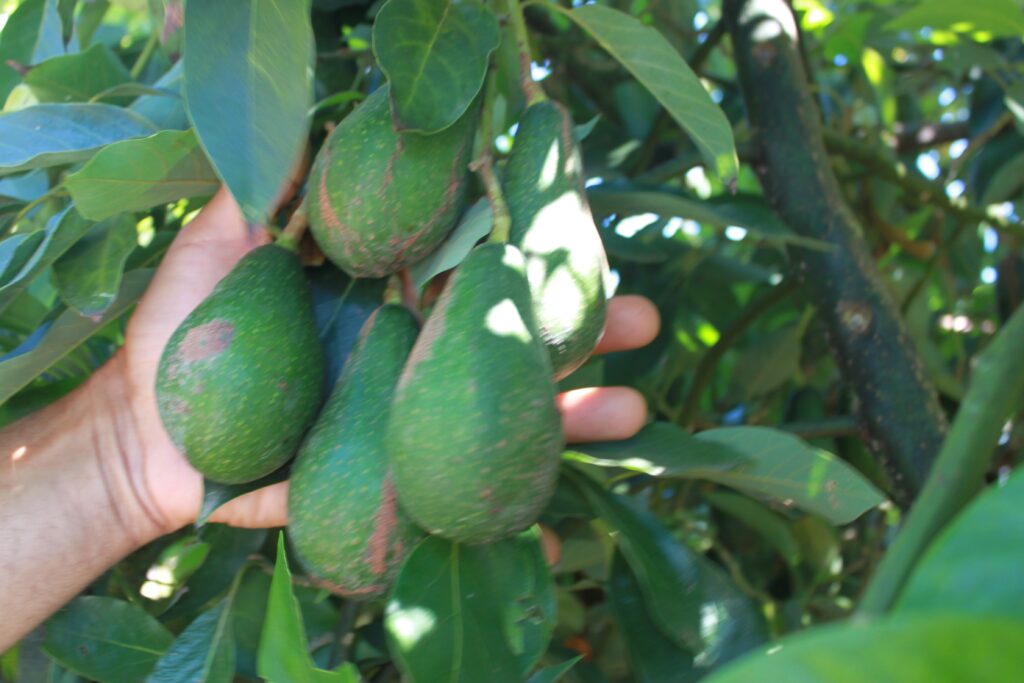
The odd looking Don Gillogly takes the long-neck look of the Pinkerton to an extreme, resembling more a slightly lurid bottle gourd. For years advertised in embarrassingly hyperbolic terms we will not repeat, this avocado has earned our affection because despite the significant shock value it can generate, it is actually very good. The moderately sized tree is also consistently loaded with fruit. This is a good one to fill the late-spring through fall window.
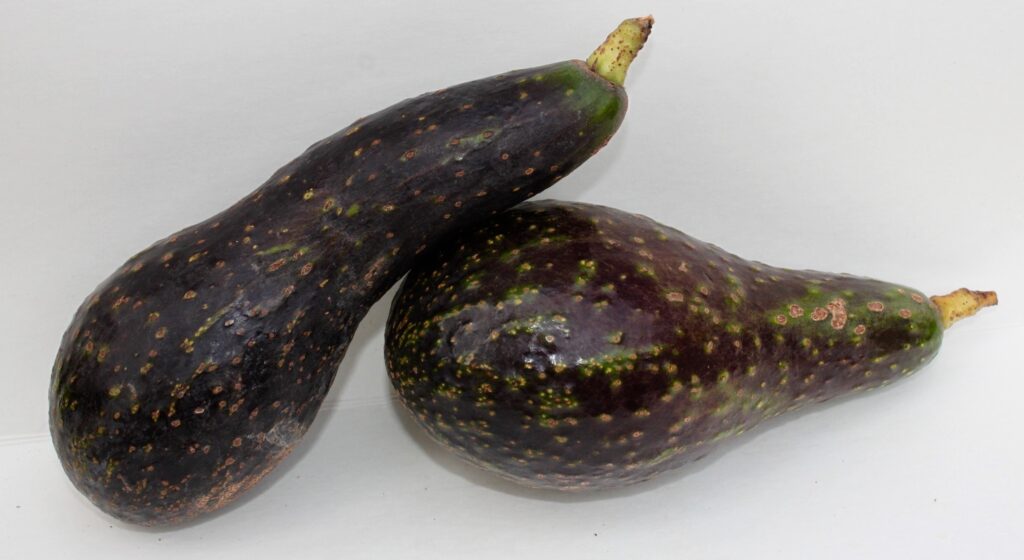
Another earlier ripening fruit that is surely worth considering is the Jan Boyce. This variety makes a small avocado that takes the rich, nutty flavor thing and amplifies it. The tiny seed almost makes you giggle when the fruit is cut open. For the small size, there’s a high yield. Downsides include being difficult to peel, and our tree has been an inconsistent bearer, sometimes stingy, sometimes prolific.
Ardith is a standout delicious-flavored avocado. Small tree, good-sized fruit that looks much like a Hass, with great flavor. This one took top marks at the CRFG avocado tasting held at the Santa Cruz Live Oak Grange.
An avocado revered for its flavor is the Bonny Doon. This is a vigorous, ornamentally lush and leafy, tough tree; taking hard freezes without damage. When it dips below 28 degrees, we expect to see some burnt leaves on our Guatemalan avocados, but the Bonny Doon keeps right on growing. The fruit is smallish, seed on the big side, but the flesh is rich, flavorful, and fatty. The tree bears profusely, but in its own atypical style. Unlike most excellent Guatemalan types, which ripen 14 to 18 months after initiation, the Bonny Doon matures in April when we are trying to finish our Zutanos. Once the Bonny Doons come in, nobody wants to eat the Zutanos but the rats. This one would be in the absolute top tier were it not for the small size and big seed.
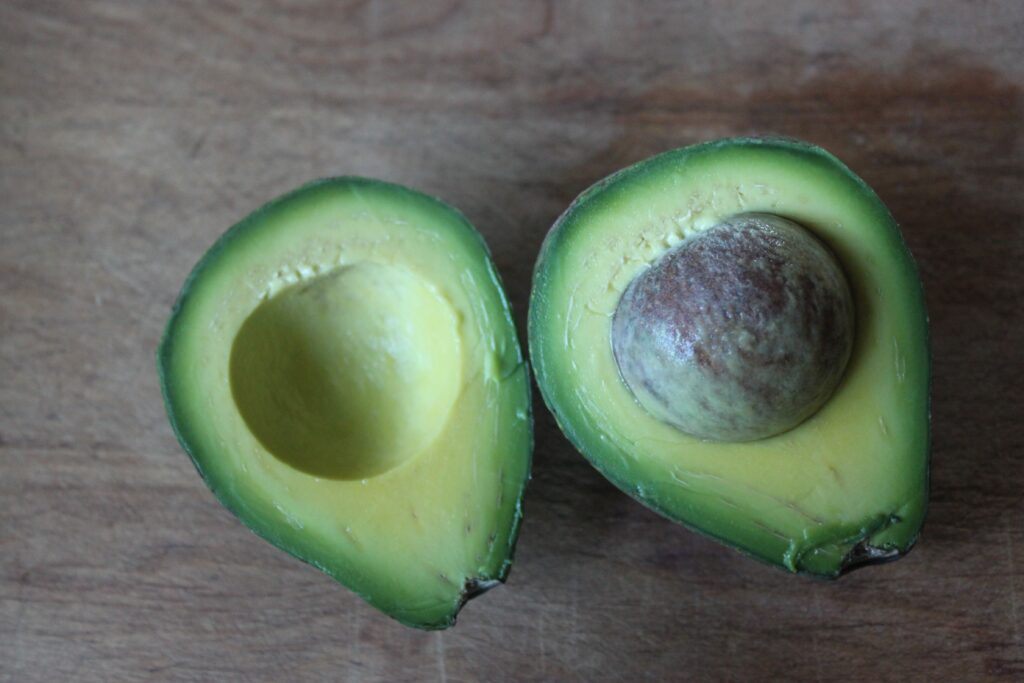
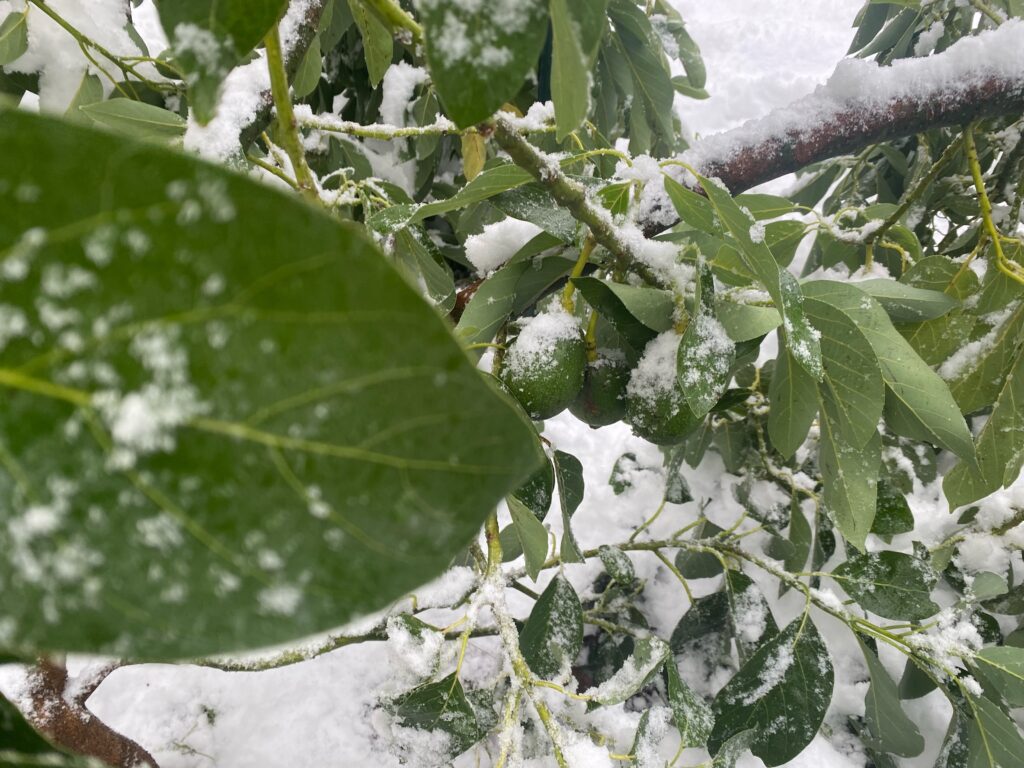
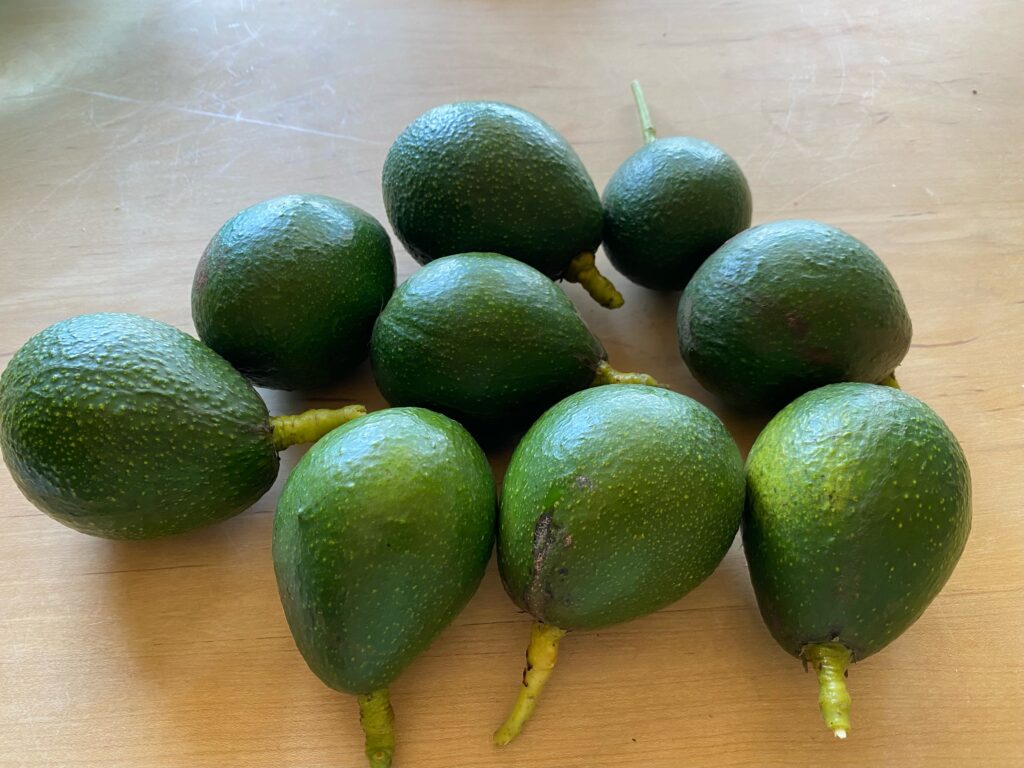
Besides the Bonny Doon there are other tough, cold hardy varieties that can form an insurance policy against hard winters. Severe cold happens regularly enough in our area that you need a strategy to deal with it. When it goes below 25 degrees, flower buds and half ripe fruit freeze-out, meaning no fruit later in the year, nor the next year, when the fruit formed on those killed flower buds would have ripened. If you plant all excellent Guatemalan types, those tend to be less hardy, and slow ripening, so it will be maybe two and a half years before your trees ripen another fruit. With a Mexicola or Zutano, the temperature required to kill buds is several degrees lower, and the delay until the next crop is reduced because they ripen 7-10 months after bloom instead of 14-18 months for a Reed or Hass. Think of it as a much shorter, tougher conveyor belt from flower to fruit.
This freak-winter strategy becomes the norm as you move into more marginal areas, and these “insurance” varieties become the backbone trees.
We’ve mentioned Zutano a couple of times and should now explain that this is a big, vigorous, workhorse of a tree, hardy down to the low 20s, dependably productive of large, less than top quality fruits. Smart to include one of these in your planting, if you have the space. We chop ours back some every year to rein it in. The fruit can be watery, and it peels not too well, but it ripens in February, when not much else does. Left on the tree until the last minute before the butt-end rots, it can be fairly rich, but never as good as a Hass type. Think of this as a guacamole avocado, but much better than no avocados at all.
Bacon falls into this category as well, the avocado you plant because it’s tough, dependable and productive but isn’t great to eat. Bacon is a little better tasting, and ripens a little later than Zutano, April into July. It can take the cold as well as Zutano.
Another interesting addition to this arsenal is the D’Arturo, a Bacon seedling from Corralitos, CA. This tree seems to have much of the cold hardiness of the Bacon, but nearly the eating quality of a Hass. It’s rich and nutty, peels well, ripens in April, and makes a lot of fruit starting at a young age. It is also a new variety for us, so we haven’t seen what it does in an extremely cold winter, like we had in ’97 or ‘91, where big avocado trees got frozen back to the stumps. In a year like that, you read the weather report, and go bury your avocados’ trunks under 4’mounds of wood chips or some similar material. Protect the graft union, and pray. After the next winter like that, we’ll give a full report. An avocado coming back from a freeze or a stumping grows amazingly fast.
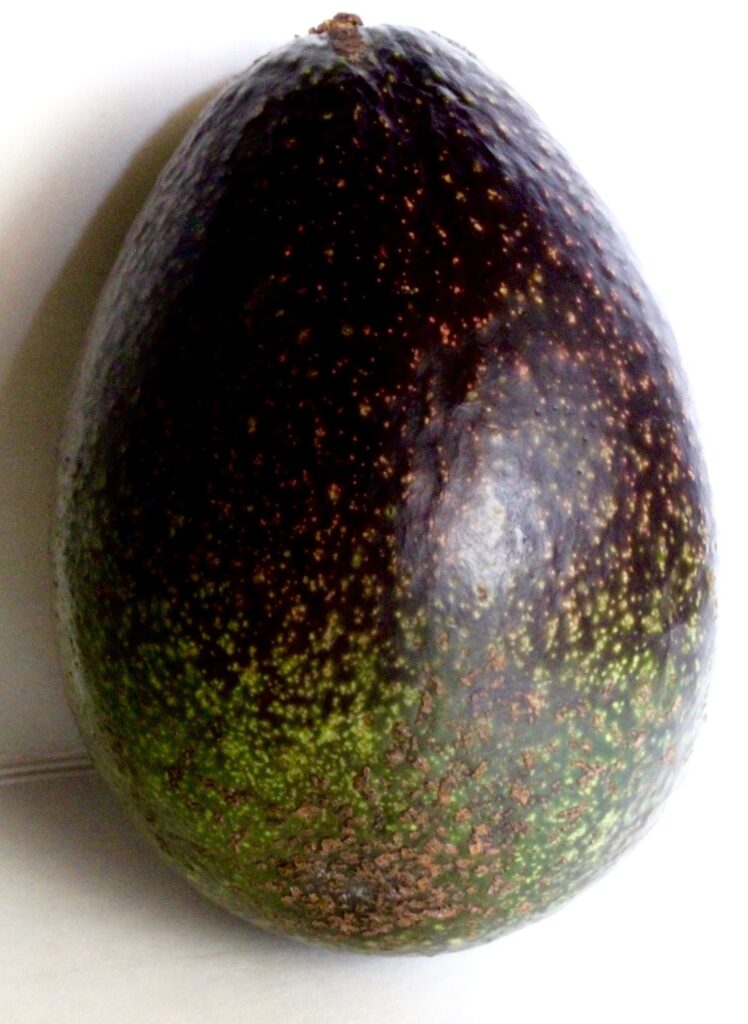
There are other more obscure avocados, old heirloom types, that sound incredible when you read about them, and may be worth planting for the collector. Edranol, Nabal, Nimlioh, Queen, Hellen, Sharwil are fabulous avocados, but sadly, they are weak bearers under our conditions. With the warm nights of a more southerly location, they can be productive additions to an orchard, but for us, they do little but lend a bit of collector cred to our plant lists, the horticultural equivalent of a chest bump.
There are many other avocados out there, some of which we have tried or are trying, but not yet ready to recommend. The above list is a good start. If you have all those types already, come and talk to us and we can provide you with some other options.
The following section of this posting is as important as the previous. It is good to know which avocados do well, but crucial also to know which ones to avoid because they’ve so thoroughly disgraced themselves in our area.
Heading the list is Fuerte. This was the leading variety grown in California until sometime in the early 1970s. Great flavor, and can be a good producer, but only in specific locations. The problem is that our night time temps at bloom often dip into the 40s, which destroys the ovaries of Fuerte’s flowers. If at any time during bloom, the low is 54 degrees or cooler, count on no avocados being produced. Our lows are almost always lower than that, and Fuerte almost never makes fruit.
SirPrize is another terrible avocado variety for our climate. Like Fuerte, It is a B-type, which classically fail to produce in cool climates. It is possible to get some fruit in some locations in a good year, but it is a losing bet.
The question could arise: “If these avocados are so bad, why do nurseries propagate them?” The answer is that we in Northern California are small potatoes when it comes to the overall market. Nurseries propagate trees that do well in Southern California, where most avocado trees are sold. Fuerte and SirPrize do better down there, so they get propagated for that region. They get sold in that region, but sold in ours as well, because that’s what the avocado nurseries have to sell.
Stuart (Stewart) is an avocado that does poorly for us, despite the irresistible promotional claims. Supposedly great avocados down south, they aren’t worth the water you’d waste on them up here. Again, maybe in a favorable year it makes something, but the space is too valuable to take-up with a proven unproductive tree.
Holiday Was promoted for being a small tree that fits in any backyard. That much is true. It makes a big beautiful fruit that would be welcome at any table. But alas, most of them are made in southern California. In our area, it is a dependably stingy bearer.
Ettinger is another avocado to never ever plant up here. It’s reportedly popular in Israel. What’s omitted is the reason it is widely planted in Israel: It is a very good pollinizer variety, not so good for eating. We don’t need pollinizers in our cool, moist climate (see pollination blog post) so it is only a very mediocre, unproductive fruit possessing all the worst traits of Zutano. Don’t be sucked in by the temptation to try the road less traveled with this one, Ettinger is a dead-end street.
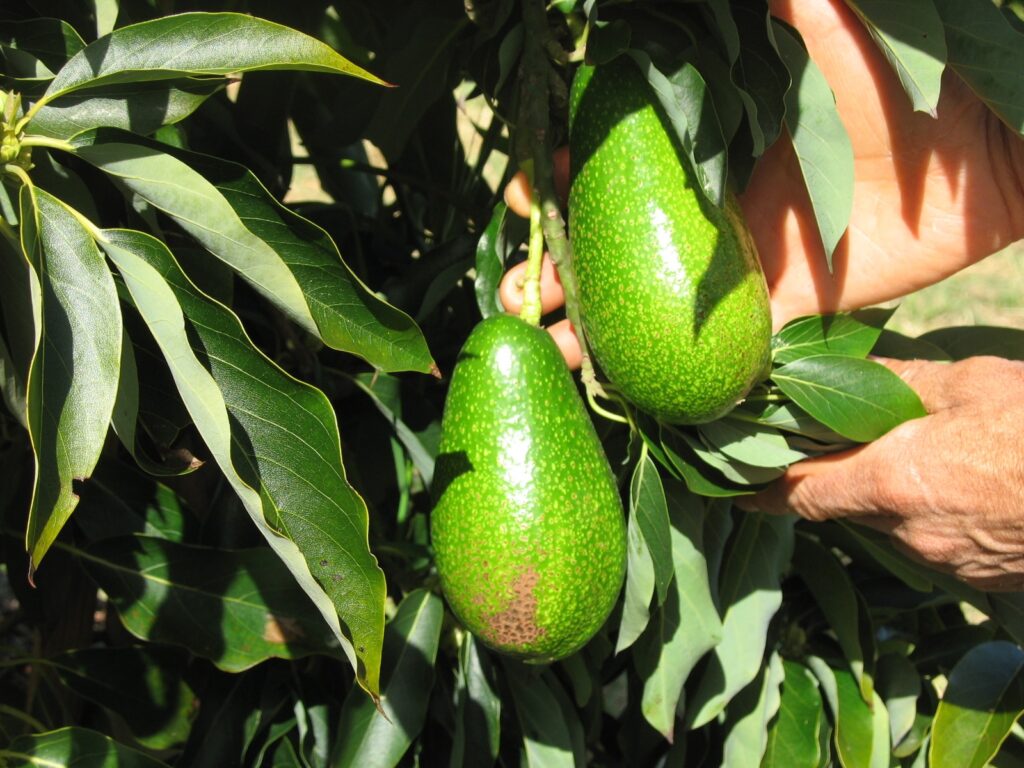
To this list the Littlecado must be added, though it isn’t quite as worthless as the previous four. Littlecado, or Wurtz as it is also known, is popular because it’s supposed to be a dwarf type. It is indeed short, but it grows wide, so doesn’t end up saving much space, it doesn’t produce well, and the fruit doesn’t taste good. The only thing this variety has going for it is the name. The image of a tiny avocado tree laden with delicious fruit is too much for some people to resist, but try to be strong, this tree does not love you, and is only telling you things you want to hear…
Oh, and if you happen to be the owner of one of these or another unfruitful, underperforming avocado tree, grafting is an excellent option. No tree is too big or too small to be grafted over to a better variety. A large tree can be cut to a stump, regrafted in the spring, and in two years be twelve feet tall, carrying a huge load of fruit. Contact us if you’ve lived with a lousy avocado tree long enough.
So that’s what we have to say about avocado choices for our own yard, and by extension, the Greater Bay Area, based on our experience so far, growing and selling avocado trees. The exciting part of the story is that every time we turn around, or several times a year anyway, someone is telling us, showing us, offering us samples of a family heirloom or newly uncovered, unidentifiable seedling avocado endowed with amazing qualities. We love this, and if we share the excitement, we gather scionwood and graft up a couple sample trees to see how they perform in captivity. There is so much more to discover of the avocado potential in our area, that it drives me to write opinionated pieces like the one above in the hopes of provoking a reaction from someone with an avocado that’s better than anything I have written about.
If you are that person, I urge you to contact us and offer us samples. If you are only interested in the results of this process, tune into our website as we announce and bring forth the fruits of our trials.
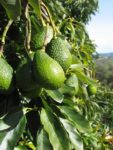
February 17, 2019
Pondering Pollination
Pollination of avocados is a subject so steeped in misinformation that it borders on disinformation. The weird gender shifting, temperature dependent flowering process is complex, specialized, and slippery, rendering it just another example of human beings propagating a fairy tale, based on innocent misinterpretation of outward appearances, underestimation of subtly nuanced mechanics, and extrapolation of inappropriate assumptions. This just seems like the way people begin to figure things out: Stacking layer upon layer of wobbly and rumpled factoids somewhat in the general direction of an explanation; it’s a dubious assumption to think we can know anything: The earth was the center of the universe for a long time, after which it remained flat and according to some, is still only 6,000 years old. People believe all sorts of garbage, till they don’t.
Crazy things pass for the truth until the time when higher functioning facts come along. This can be said of almost any subject, lending an implication of substance to the impression that people are getting smarter all the time. We’ve been saying that about ourselves forever, but a cold-eyed assessment of our current ecological, political, and sociological situation discredits any confidence in that notion.
Even if we aren’t as a species encroaching upon enlightenment, maybe as far as avocado husbandry is concerned, some of us might be bumping around in the dark toward proficiency.
What sea-change in understanding will next year bring?
A discussion of avocado pollination requires this kind of preamble to acknowledge the tenuous nature of our grasp on this issue. Waves of studies published in the last ten years have come out contradicting foundational aspects of earlier work. What new work will arrive next year that amends or refutes what I’m reporting here? It is an almost entirely unsettled science, but the confusion is understandable since the subject is as highly nuanced as it is complex. Avocados behave uniquely in each location, and from year to year. Rather than attempt to fabricate a static rule that applies to every evasive aspect of a dynamic situation, maybe the best we can do is to take a look at some of the underlying roots of that variability, and try to consider some of the crucial factors when planning our plantings.
Avocados are engineered for southern Mexico
In southern Mexico, the avocado’s homeland, pollination isn’t an issue. The infrastructure is all in place for them to make fruit: The trees are adapted to the climate, and under minimal stress. The co-evolved insect pollinators are present. The weather is tuned to their specific reproductive mechanics through millions of years of selection under those conditions. In its native soil, avocados fruit abundantly and effortlessly.
In central California, 3,000 miles to the north, pollination is perhaps the most crucial limiting factor. The reasons are many: shortage of effective pollinators, excessively cold Winters, cool Spring bloom conditions. Avocados are a bit out of place up here in the North, but can produce well enough to show there’s potential, and allow us to distinguish some reasons behind those successes and failures.
Gender bending avocado flower orientation
Avocados in their comfort zone (68°F at night, 77°F daytime) follow a pollination pattern unlike any other plant. The A-type flower opens, as a receptive female, in the morning of the first day. After a few hours, it closes, and opens again the afternoon of the second day as a pollen-producing male. The B-type tree, which is hopefully nearby, has a complementary pattern: Flowers open as females in the afternoon of the first day (coinciding with the opening of the A-type male flower), close, then open the morning of the second day as males. All of a given day’s flowers on both A and B-type trees open and close in a synchronized fashion: Today’s A flowers pollinated by yesterday’s “B”s, todays “B”s by yesterday’s “A”s.
All this works smoothly, as long as conditions are right.
Casting suspicion upon the B-type avocado
The widely held and durable convention that would insist upon a B-type avocado planted nearby any A-type, is based squarely on the above coordinated flowering pattern. In warm climates, this is a necessity, and has become standard practice wherever avocados are grown. Orchard planting protocol insists on placing one pollinator tree, like a Zutano for instance, centered among every eight Hass, Lamb, or Reed trees. If you go down to buy a Pinkerton tree at the garden center today, the staff will recommend you put in a Bacon, or ask if you have some other B-type nearby. When we planted out our collection, we made an attempt to alternate our varieties A B, A B. What we found is that our A-types fruit faithfully, even sometimes prodigiously. The B-types hardly make anything. More than ten years out, we know it’s probably not just a matter of letting the trees become established; there is something wrong with our B avocados. When you read about yields, talk to people about how their avos are doing, this pattern is confirmed: In the cool Central coast, Bacon and Zutano fruit well, any other B-type is basically a loser. Sir Prize, Sharwil, Nabal, Nimlioh, Fuerte, Edranol, Queen, Hellen, even Ettinger: all unproductive.
Cold temps impede avocado pollinators
Where I live, on the coast near Watsonville, California, night-time lows at bloom never average 68° F as they do in Puebla, Mexico. It’s usually more like 45-55°F. At these temperatures, the native insects that co-evolved with the avocado species can’t survive. They stay down in the avocado’s native range. We rely on the Honey-bee (and other native pollinating insects when present) to do this work. Under the right conditions they suffice, but the honey bee, the most common pollinator, doesn’t particularly like the relatively low-sugar avocado nectar, and has been observed scraping pollen from it’s legs while leaving flowers. It will avoid avocados when other flowers are around. In the Spring when avos are in bloom, many other flowers are available. As if that weren’t enough, pollinating insects are less active or absent at our lower Spring-time temperatures.
An avocado flower needs insects to bring it pollen
Avocados need an insect to move pollen between male and female flowering parts. The pollen source must be very close as honey bees generally don’t travel very far between trees. With thousands of flowers to pollinate, they have plenty of work to do on a single tree. Add to this the sticky, clumpy nature of avocado pollen that prevents it from moving easily from flower to bee and back to flower. Several visits by a pollinator are therefore required for enough grains to be deposited on the flower’s stigma to trigger release of the chemicals needed to stimulate pollen tube growth. One or two pollen grains will just sit there, waiting. Typically, 20 or more pollen grains constitute a tipping point, ensuring the presence of enough candidates to make for a good race. Only then are amino acids secreted that stimulate the grains to crack open and allow pollen-tube elongation; all the tubes begin extending down the style. Only one, the most capable, fastest and first tube to connect with the ovule, completes fertilization. The simple act of pollination, depositing of enough pollen grains on the female flower’s stigma, seems unlikely enough, but there’s a whole host of impediments to the process of fertilization and fruitlet formation.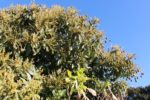
Cold weather causes fault prone fertility
If we assume adequate pollination happens to occur, and pollen tube growth begins, cold temperatures slow it down. Some varieties have only a 48 hour window for the pollen tube to reach the ovary. Below 50 degrees, all avocados suffer. For some, the clock can just run out, and both pollen and ovary die before fertilization is accomplished. Further complications include the fact that some avocado flower ovaries (Fuerte and Sharwil for example) are killed by cold at 50°F. At these temperatures, many avocados produce faulty, defective female flowers, incapable of being fertilized. Fuerte and Sharwil produce very few female flowers under our cool conditions. These and other factors foil your avocados’ performance, and are reasons why productivity fluctuates with cultivar, location and conditions.
Freezes can destroy the potential crop
Before fertilization and fruit-set even have a chance to occur, we need to back-up and state the obvious: first there has to be a proper bloom to pollinate. As a worst case, we’ve seen several winters where freezes killed all the small branches on our trees, resulting in total destruction of even last year’s crop, and no bloom at all for the current year. Often we see partial die-back that results in reduced bloom, and a diminished crop. Usually we have what appears to be plenty of flowers, and even the B-types bloom profusely, with insects criss-crossing between clusters, and yet they still refuse to set a crop. Something seems wrong, and it is.
Cold weather delays flower opening
As temperatures deviate from the ideal, flower synchronization also goes sideways. It’s been observed that for every 1 degree below the ideal 68 degree night-time average, flower opening is delayed by 30 to 60 minutes. It’s easy to see how a 15 degree temperature deficit, resulting in a 7-15 hour delay in initial flower opening would change everything. A-type flowers that should open at 10 AM, might open at 5 PM or later. In a B-type tree, female flowers open initially in the afternoon, or say 2 PM under ideal conditions. With a 52 degree night-time temperature, initial opening might begin at 10PM. It’s obvious how this delay could affect pollination chances, as honey bees won’t fly when its under 57 degrees, or after dusk. It’s also easy to see how this might affect B-type flowers more acutely, as more of their female fruit-producing bloom occurs when few if any pollinators are present.
Cold weather lengthens the whole process
At lower temps, the duration of the entire flowering cycle is extended, so the A cycle might take 72 hours to complete, given 50 degree night time temps, instead of the “ideal” 36 hours. This results in a tree no longer anywhere near perfect synchronization, but with flowers at any given time in all stages of opening and closing, even within the same cluster. This chaotic bloom pattern requires random chance to bring the male and female flowers together at the same time. The B-type flower has a naturally shorter flowering cycle, that is even more adversely affected by cold, with the female stage opening at night, defectively, or in many cultivars, not at all. Obviously, when the female stage flower fails to open, or open properly, as it tends to in the B-type varieties under cold conditions, there is a vastly reduced chance of setting fruit.
Avocado flowers are bizarre, but self compatible
The avocado’s flowering system represents a completely unique conception of gender. No other organism on earth shares this system. A very strange, complicated and tightly choreographed dance when it’s working properly, this strategy (described above) is presumed to aid outcrossing, discourage self-pollination, and thereby promote genetic diversity.
In many other plants this end is accomplished through an internal self-incompatibility, whereby a plant’s own pollen won’t be as fertile with itself as would some more diverse source. This results in fertilization failure, or weak growing or defective offspring that mostly won’t thrive and be selected for. Broad genetics have been encouraged in animals by the evolution of genders, furthered in some cases by hormonally, or culturally triggered aversions to inbreeding. Avocados are among the most basal, or primitive of the flowering plants, and display a unique, perhaps primitive, facsimile of these other self-incompatibility mechanisms. The switching of flower-sex acts like gender specialization, but isn’t, because the individual trees can, with equal effectiveness, fertilize their own flowers. Alternating between male and female phases limits opportunities to in-breed, but given the chance, avocados are fully capable of it.
Cold changes the rules
What this means for us is that, though A and B types in close proximity are required when avocados are grown in their native conditions, this tight relationship falls apart up here in the North. To the extent your growing situation mimics the ideal, your A and B avocados will compliment one another in pollination, and probably fruit copiously, provided they are close enough to one another, and have insect pollinators around to do that work. To the extent your growing conditions are like mine, hitting low-50s in bloom-time, all of the cold weather effects combine to ensure that your trees’ flowers aren’t opening on schedule. The rules don’t apply when the trees go out of sync. Facing this dysfunctional behavior associated with Central California, one might question the sanity of even attempting such an ill-suited crop as the avocado, and yet, everyone has seen trees full of them. What, we may wonder, is going on here?
Chaos has an upside, making pollinizer trees pointless
So we talked about cool weather, and the down-side of long drawn-out flowering cycles, and how that means male and female flowers no longer open in a synchronized, complimentary fashion. The self-compatibility of the avocado suggests that this may not be such a bad thing. Chaotic flowering habits in our climate mean both male and female flowers are almost always open together on the same tree. The silver lining here is that “close-” and “self-” pollination become not only possible, but preferable. What’s meant by close-pollinated is when a flower is pollinated by another flower within the same cluster, or on the same tree, or by a tree of the same variety. Self-pollination, in this case, refers to when a female flower is fertilized by its own pollen. This is much easier for a pollinating insect to accomplish than moving pollen around the orchard, from 3 or 5 trees away. Recent research suggests that pollinizer trees must be very close to make an impact on pollination. More than 27 feet away from a pollenizer is essentially the same as having no pollinizer at all. Even more recent research suggests that in certain climates (like ours on the central coast), this makes no difference at all. Presence of a pollinizer tree, A-type or B, makes no statistical impact on yield.
Self-pollination within the same flower
There is a further deviation from standard pollination mechanics operative in our area. Like a broken record, people repeat: female flowers open for only a few hours, then close, and open a day or so later as functional male flowers. This is true under ideal conditions, it’s true in arid areas of California, true even in some of the hotter, dryer parts of our county, but under coastal conditions something else happens. It seems that in the cool, moist weather that some of us experience here in the Spring, the stigma, or female pollen-receptor part of the flower, remains viable for a short time after the flower reopens “male”. The duration of this “gender overlap” depends mostly on humidity. Under 60% humidity, the stigma will dry out and turn brown upon opening of the male phase. Above 70% humidity, the stigma can remain moist and receptive for up to several hours. Of course these conditions vary with time and place, but when it’s the case, only a matter of millimeters separate pollen-laden anthers and a ready, and awaiting stigma. The new assumption is that perhaps 80% of our avocados begin life pollinated in this way, during the first hours of the “male” phase.
B-types are more harmed by the cold, but exceptions exist
I have abandoned any discussion of the B-type cultivars for a while here, since they are so ill-suited to coastal central California’s climate. The cool weather that extends the viability of the female flower parts into the male flowering period that so benefits the A-types, does little to help the B-types. Those same cool temperatures can disproportionately kill-off the B-type’s ovaries, prevent proper female flower formation, delay female flower opening until after nightfall, and otherwise disrupt fruiting. There is a huge variation in response to temperature, and some A-types, like Littlecado are also thrown-off by the cold. A few B-types like Bacon, Zutano, and perhaps Nowels, break ranks, and produce faithfully in cool conditions. Also absent here is any attempt to explain the experience many have had with the Gwen avocado. That fruit supposedly produced heavily and consistently in the breeding block with many diverse pollinizers, but when field tested in single variety blocks, it failed to bear. The Gwen in my yard did the same thing, disappointing me for years until I surrounded it with diverse pollinizers, at which point it began fruiting heavily and consistently. Pinkerton is also prone to fertility problems in cool weather, and there are certainly other examples of idiosyncratic behavior among the diverse avocado varieties.
Plant B-types sparingly on the coast
For us on the Central coast, we have a unique avocado growing climate, that varies wildly with our micro-climates.The characterization of bloom and pollination mechanics laid-out above imply a list of prescriptions to bear in mind when considering your avocado plantings. The first item on the list is to go light on B-type avocados that are not Bacon and Zutano. The more perfect your avo growing situation the less true this is. An ideal Sunset zone 16 site in the southern part of the state, and a little back from the coast, can provide much more nearly ideal flowering conditions: With warm Spring nights, frost free winters: B-types can produce respectably. The South Coast Research Station’s Julie Frink says “B”s are for inland, “A”s are for the coast. A question to ask yourself is “How cold does it get during bloom-time?” If at any point it drops below 53 degrees during bloom, B-types won’t work well. Below 50 degrees, all varieties will experience some degree of failure.
Take away
We are growing our avocados in a distinct climate from what they were evolved to encounter, and they behave differently under these conditions. It only makes sense that pollination planning should reflect what’s really happening. Since flower synchrony isn’t occurring except under the most exceptional circumstances, A-type B-type matching isn’t functional. Since B-type avocados perform very poorly up here, except in the most unusual situations, they should be avoided if fruit growing is the objective. Since pollenizer trees aren’t necessary, it may be tempting to plant only one variety, say all Lamb or all Reed. This may work fine, pollination-wise, but other considerations may trigger taking a broader approach. Temps and conditions vary year to year, requiring planting trees with a range of hardiness for insurance reasons. Ripening times of the various cultivars differ, with year-round harvesting attainable through the planting of 3-4 types. Fruit size and flavor also vary, plus, it’s often tempting to experiment with new types. Regardless of what you’re planting, all avocados require warm, mild temperatures to produce properly, demanding they be planted in our most sheltered, frost-free spots.
Many more issues to unravel
Still plenty to tease- out when it comes to avocado culture. Questions abound on what’s the cause of and how to prevent the various waves of premature fruit drops? How can we prevent, even out, and correct biennial bearing? How can we increase fruit size and yield? Can we find a truly Phytophthora-proof rootstock? Also puzzling is the issue of what’s going on with Zutano and Bacon? Why are they so exceptional? They break all the rules of B-type avocado production. Is there something peculiar shared by these two cultivars? We have not even mentioned the dirty little subject of ovarian starch content, whereby only a small percentage of the million or so flowers on an adult avocado tree have even a chance to develop into a fruit. The rest, damned by low starch provisioning, face certain abscission. Most importantly, some serious work needs to be done determining why the branches on my trees hanging over the neighbor’s fence tend to produce the biggest crops.
Other questions abound for which there are long, partially formed answers, beyond the scope of this posting. We’ll see what happens in the next one.
March 3, 2012
Oh it’s been a long time since I’ve had my hands on a keyboard. When you write a blog, you need to do it more than once, or it isn’t a blog anymore, it’s just something you did once. To get me to sit down behind a computer screen, there’s got to be a pretty powerful trigger event. The recent cold weather has given me that impetus. Yesterday, the 18th of January, our town, La Selva Beach, claimed the county low of 25°. We’re just northwest of Watsonville, a mere ¾ of a mile from the ocean, but it gets surprisingly cold here. I recorded 26° in a spot under the canopy, against a fence (surely not the coldest place) in my grove. The previous week has been cold, as has the entire winter, with frost nearly every morning since early December when we dipped down to a low of 27-28°. The last three days have seen the mercury in my yard fall from 28° on the 16th, to 27° on the 17th down to the low of 26° last night.
I’ve not exactly been hoping for this kind of extreme, but it does give us a chance to observe how some of these experimental avocados fare. That is the question at the crux of this whole exotic avocado project: Can we expect to successfully grow a Sharwil avocado in our yard, or must we resign ourselves to the thin pleasure of merely planting them over and over again? Maybe there’s a mathematical equation describing the waning satisfaction in each successive failed attempt, ebbing to a refusal to try another one. Being the first damaging cold many of these young trees have seen, this is our chance to begin to understand what varieties are going to work for us.
Only spotty data is available on the relative cold hardiness of the avocado varieties we’re trying. Most of it’s from southern Ca., and not very encouraging. Have these varieties even been tried in Santa Cruz County before? If so, the tablets were lost. This is a condition endemic to fruit growing. The various western garden references are but a barest of beginnings. The work of determining the best things to grow is ultimately our own, because everyone’s site is unique and non-uniform, our needs and tastes differ, and lots of good thing have never been tried.
The report offered here won’t apply to everyone’s situation. You might even laugh at the fact that it’s only a single thermometer (not even digital) upon which I base my data, and so can know almost nothing about the actual thermal landscape of my yard. These trees, however, are all planted pretty close together (within about a 75’ radius), subject to more or less (as noted in the table below) the same conditions, so there may be some value in comparing and reporting on the damage sustained by each variety. To the extent your place is like our place, this information may be useful.
| Variety | Desirability of Location | Condition of Tree | Tree Size | Extent of Damage |
| Jan Boyce | Fair | Poor | Small | 3 |
| Hass | Prime | Very Good | Large | 2 |
| Nabal | Prime- | Fair | Small | 5+, 3 below |
| Edranol | Good- | Poor | Very small | 0+ |
| Nimlioh | Fair | Good | Small | 3 |
| Hellen | Fair | Good | Medium | 2+ |
| Koala | Prime- | Good | Very small | 1 |
| Big Sur #2 | Prime | Very Good | Medium | 1 |
| Big Sur Round | Prime | Very Good | Medium | 0+ |
| Lamb | Prime | Very Good | Large | 1 |
| Zutano | Prime | Very Good | Medium | 3 |
| Ardith | Prime | Very Good | Small | 1 |
| Gwen | Prime | Very Good | Large | 2 |
| Jan Boyce | Prime | Good | Large | 3 |
| Queen | Prime | Very Good | Large | 2 |
| Sharwil | Prime | Very Good | Small | 4 |
| Magoon | Prime | Good | Very Small | 4 |
| Daily 11 | Prime | Good | Very Small | 3 |
| Bird Avenue | Prime | Poor | Very Small | 0+ |
| Hellen | Prime | Very Good | Large | 2 |
| Greengold | Prime | Very Good | Medium | 1 |
| Sir Prize | Prime | Very Good | Large | 2 |
| Bonny Doon | Prime | Very Good | Large | 2 |
| Gem | Prime | Very Good | Large | 1 |
| Reed | Prime | Very good | Large | 2 |
| Lamb | Prime- | Very Good | Large | 2 |
| Gem | Good+ | Very Good | Large | 2 |
| Pinkerton | Good | Very Good | Large | 2 |
| Ettinger | Good | Very Good | Large | 1+ |
| Carmen Hass | Fair | Very Good | Large | 2 |
| Ettinger | Fair | Good | Large | 2 |
| Ibis | Poor | New Graft, fresh shoots | Small | 5 |
| Holiday | Good | Fair | Small | 3 |
| Nowels | Prime- | Very Good | Small | 2 |
| Bears Lime | Prime | Very Good | Small | 2 |
| Lavender Gem Mandarin | Fair- | Very Good | Medium | 2 |
Damage Rating:
0= no apparent physical damage beyond minor discoloration.
1=almost no damage, only a few tender tips
2=minor damage to tender growth on part of the tree.
3=minor damage to tender growth throughout the tree.
4=clusters of leaves burnt, including larger leaves.
5=mature leaves killed and twig tips burnt back a few inches.
Condition of tree rating (pre-freeze):
Poor=yellowish green color, sparse, blotchy leaves, stalled growth.
Fair=greenish color, thin canopy, blotchy leaves, stalled growth. Good=green color, full canopy, some signs of growth.
Very good=dark green color, dense canopy, strong growth.
To the extent you’re growing some of the varieties listed in the table above, this first installment of information may help you gauge whether it’s worth trying some others you know not of. Up here in the avocado outer-reaches, we need to plant the best varieties that have a chance (even if we’re alone in doing so), and we need some luck. We need to be open to all possibilities, but open as well to the facts when they indicate we’re wasting our time: sometimes a tree just needs to be chopped out. This job requires a certain degree of cold brutality, tempered with fair-minded leniency. To not botch too badly this winnowing process we need to tease out some of the various factors influencing a particular trees failure:
Condition of tree is important: Stalled-out, yellow, salt-burned avocado trees are less hardy than healthy ones of the same variety. High nitrogen levels make avocado leaves more cold resistant. A tree that looks blue-green, may slide right through a cold event without damage if it’s between growth phases. With new shoots all over it, the same temperatures may burn it badly, but growth often resumes in what’s survived of those shoots, as soon as things warm up again, leaving you with a bigger, better tree come springtime.
Size really does matter when it comes to avocado cold hardiness. Large canopies hold more residual heat than tiny shoots, insulating the inner parts of the tree. So full bushy trees will take more cold than naked straggly ones. The most vulnerable situation would be the tender shoot from a fresh graft: all soft exposed stem, widely spaced, large succulent leaves. A tree in this condition could be several degrees less cold tolerant than a full, healthy specimen of the same variety.
Position in the grove can spell doom for a tender variety that would succeed in a more favorable spot. The temperature varies all over my yard, depending upon whether it’s a high spot on the south side of a fence, for instance, or behind a structure, shaded at sunrise, on the bottom of the yard where the cold air accumulates. The differing damage levels between the few duplicate trees in my planting indicate, if only weakly, these effects.
Some of the results in the table above are noteworthy, because they’re either extremely good or extremely bad. Starting with the most stunning failure, the hardest hit tree in the yard was the Ibis. This tree was just grafted onto the stump of our former Fuerte tree, in late August. At the lowest point in our avocado line, against a cold air dam in the form of an eight-foot hedge, shaded from the sunrise by the neighbors’ Winnebago, this is unquestionably the worst spot in the grove. The original Ibis mother tree, a 30-foot tall, 50(?) year old chance seedling was discovered last spring in Corralitos. It was loaded with tasty, long-necked, Feb-April ripening Mexicola-type fruit weighing up to one pound each. Growing as it was in a cold part of the county, and displaying Mexican genetic traits, we guessed it would be happier in this bad spot than the Fuerte was. We guessed it would prove itself to be a great new avocado for colder climates. We guessed it was our best chance to rapidly screen our view of that blocky white Winnebago. Maybe we guessed wrong. All tender green shoots and succulent young leaves, our little Ibis had no canopy to speak of, no hardened-off leaves, and everything burnt back to ¼ inch stems.
You might think privately that only an idiot would be grafting avocados outside in late August. Isn’t that inviting failure, waving all that tender new growth at the frosts coming only a couple months away? True, it’s not very smart, but our mid-May graft attempts failed, and the mother tree was being removed. It’s gone, through the chipper now, so we had one last chance. The 5/8 inch main stems look fine, the tree will live, but it inspires empathy. Combination bad position and vulnerable condition will prevent us making any snap judgements on this variety. We’ll wait and see how it does in the future with a full, hardened-off canopy.
Next worst was the Nabal, despite a much more favorable location. This small tree has not grown well, and went into winter with old looking leaves and exposed, sunburned stems in the top of the tree. These mostly turned black, leaving a crown of dead twigs and clusters of full-sized, blackened leaves, while the bottom ¾ of the tree looked only lightly damaged. It seems this is a slightly frost sensitive cultivar made more vulnerable by the poor condition of the top branches. It’s encouraging to see clusters of tiny shoots forming throughout the still-surviving upper parts of this and most of the other damaged trees. Could the burn-back act as a growth stimulus? This is the first time my Nabal has ever shown any enthusiasm.
Next is the Magoon and the Sharwil. They stand 7’ apart in the grove, and appear similarly afflicted, with blackened clusters of leaves from the recent growth flush. The damage is evenly distributed, but superficial in that only the freshest growth appears damaged. The Magoon is notable in that it is actually two trees: our original tree that’s always looked to be near death, and another one we grafted onto a vigorous rootstock and planted a foot away for insurance. The sallow, chlorotic, original tree is not quite as badly damaged as the healthier newer tree. I think it’s supposed to work the other way around, but the trees don’t seem to know that. Both the Sharwil and the healthy Magoon were grafted this March.
It needs to be mentioned that some trees just seem to be smarter about cold weather than others. The Reed, Hellen, Greengold, Bonny Doon, Ettinger, and Lamb to a lesser extent, all managed to restrain themselves from throwing out quantities of early bloom. In contrast, Hass, Gwen, Carmen-Hass, Pinkerton, Queen, Nowells, and Jan Boyce were all sporting open flower clusters which mostly froze off. Particularly disastrous was the nearly complete loss of the Carmen Hass trees’ November-set crop. This tree hardly makes any fruit in the spring, when it’s supposed to, but it starts blooming again in late September. The honey bees are more desperate in the Fall, as they rummage through the clusters like thrift store shoppers, while the Spring bloom they treat as they do my other avocado flowers, with almost complete indifference. (Not to brag, but the Carmen Hass held onto more than 50 fruits last November, and the new crop looked just as good until this freeze.) So, except for the late Fall fruit-setting varieties, an early flower thinning can actually be a good thing. It has been shown to increase fruit set, provided there are enough undamaged flower buds remaining. Still, I prefer the control afforded by a sharp pair of Felcos, and I like it when my avocados bloom late.
The various problem trees mentioned above aroused my maternal instincts. I was disappointed at their shortcomings, but not surprised, as I suspected their weaknesses. I’m optimistic about their futures as I feel most of the fault for their failures lies with us, in their shaky condition and/or their very youngness. Time and attention can cure both, and when these trees have more ballast to them, we’ll better be able to judge their relative hardiness.
Some trees in the grove deserve notice not because they failed us, but because they met the challenge unexpectedly well. The Queen had only minor damage to the tenderest leaves. Greengold was another one I was worried about, but it came through with only a few tiny tips burnt. The Ardith, newly grafted in April, grew to four feet, but pretty whippy and thin. Upper leaves discolored, but only the tiniest tips were singed. Koala, Big Sur Round, Gem and Edranol showed great resistance, boasting only minor reddish brown spotting on otherwise sound leaves. Carmen Hass and Reed were both carrying big crops of well developed fruit, none of which was damaged. The tree most unscathed was the Bird Avenue seedling from Willow Glen. With dense, nutty, Greengold-like flesh, we loved these fruits when Jeffrey Wong of the Santa Clara CRFG shared them, scion-wood, and the story of the tree with us last spring. Grafted in late April, planted out in July, it has looked pretty sickly and hasn’t grown much since. Our Bird Avenue tree still has a weak look to it, a bit yellow, stalled-out and vulnerable looking, but the cold seemed to cause no harm.
I feel as un-entitled to celebrate these seeming successes, as I am reluctant to bemoan the tender trees’ failures. One freeze provides insufficient data to decide anything. A harsher cold snap might kill some things, or require special protective measures, and would certainly provide us with more data. 26° is only a normal season’s low, but it is encouraging, because the trees all seem able to withstand it, and will come through to the spring with blossoms, and fruiting potential intact.
This is the basic test they need to pass. This minimum hardiness is especially necessary for avocados. They’re usually too big to protect before they bear fruit, and they carry their fruit through at least one winter, and up here, often two. I feel more secure knowing I needn’t pray for a string of miracle years if I want a chance to eat a Sharwil or a Queen from my own backyard. Maybe I’m jinxing myself, but these varieties display a durable toughness beneath the tantalizing fantasy. They can tolerate a normal year’s cold at my house. That doesn’t mean they will make me lots of fruit. They may not make any fruit, but hope is alive, and the honeymoon can go on a little longer.
April 2011
Epicenter Nursery & Fruit, our avocado tree nursery, was born out of frustration at our failure to locate the truly great avocados of the world we’d gotten wind of through the writings of Julie Frink and others. Watery Zutanos, Bland Bacons, delinquent Hasses, bitter little ‘cados, stingey Stewarts, fickle Fuertes are what we as consumers are stuck with, and when someone says they love avocados and are growing all the different types, their list rarely extends beyond these. For twenty years we’ve been exploring the staggering spectrum of flavors in the apple world, out beyond the land of the red and golden delicious, and when we finally cut out that old cypress hedge and made a commitment to living off the fat of our own land in the form of avocados, we knew with near certainty we’d be richly rewarded for looking beyond the workhorse commercial varieties.
Forgive my ingratitude; it’s not avocado snobbery so much as recognizing the practicalities of fruit pedaling. Hass is king of the market for good reasons: It’s delicious (though not the best) and way more adaptable than the also- delicious but tender flowered Fuerte it dethroned. It peels well, it stores and ships well, comes in a convenient and affordable half pound size, and can be harvested over an extremely long (8 months +) season. The clincher however, the trait that won Hass it’s spot atop the avocado world is it’s black (bruise and bump concealing) color that made it look and therefore sell better than the green-skinned competition. So what’s not to love? We do love the Hass avocado, but don’t believe the hype, some of those important marketing traits aren’t traits we, as backyard avocado growers and lovers, care about, or even desire. I don’t care if my fruit is black or not, or roll evenly through sorting machinery, or store for two weeks or six months at 34 degrees. I do, I really do want to grow huge, three-pound avocados (if they’re delicious), even if (maybe especially if) they’re oddly shaped. I will tolerate imperfect peeling, variations in ripening schedules, or countless other quirks and idiosyncrasies that might trouble me if I were selling to Safeway. There’s nothing sacred about the Hass, We are free to embrace a much broader array of attributes in an avocado if the eating quality merits it.
Besides the particularities I don’t need, there are also some things about the Hass I don’t like. Hass is slow. We own a pampered twelve year-old Hass tree that’s made less fruit in its life than our four year- old Reed has. Hass trees are big. Reed, Edranol, Magoon, Sharwil, Pinkerton are smaller and fit in a yard better, pick easier. Flavor is another factor. Hass is not the best. It’s not as rich as a Green Gold (but it’s cold- hardier), or a Sharwil (ditto), or as nutty as a Jan Boyce (but it peels and stores better), or a Reed (Reed does everything better except tolerate freezing temperatures) or a Nabal (but it crops more consistently), or even a Bonny Doon. Hass is not as profound as a Nimlioh, or a Queen or a Daily 11 (weighing in at over two pounds each), or even a Hellen (weighing in at a mere pound and a half). Hass is very good, good enough to become an icon, like the Red Delicious did in the apple world. It has monopolized our conceptions of what an avocado is. It’s prevented a generation or two from even wondering what else is out there.
“What are we missing?” That’s the thought seeping through our minds when first we encountered Julie Frink’s articles in the Fruit Gardener magazine a few years back.
It was the impetus behind our pilgrimages to meet her, buy trees, taste fruit and discover more fully the treasure she is. Her work with the U.C. Irvine avocado germplasm repository has afforded her the rare opportunity to evaluate more than 150 avocado varieties. Her generous power-hitting personality, practical imagination, skill and dedication as a propagator, and opinionated and entertaining writing style have spawned a minor frenzy of avocado interest. We are grateful for her work and her being, she has both inspired and provided for us.
How amazing is the privilege to trial these avocado varieties that have never before been grown in northern California. We get to observe the little quirks that give each variety a sort of fingerprint, that determine whether it’s adapted for growing here or not. Like for instance the fact that the Jan Boyce, perhaps best tasting of all the avocados, seems to flower late here, waiting somehow for the warmer nights of May to bloom and thus succeed in setting fruit readily. Sharwil, reputed to be cold tender, yet there it was a solid clutch of five or six big fruit hanging from that unlikely looking branch grafted to the underside of a friend’s Watsonville Pinkerton tree. The robust, sturdy looking flower stalks on the Hellen last year when it first bloomed, seemed impossible that they would all fall off. It’s probably an exaggeration to say it makes you feel like Christopher Columbus discovering the new world when you grow something really good that’s never been even tried here before, but it’s got us hooked. Care to join us?

